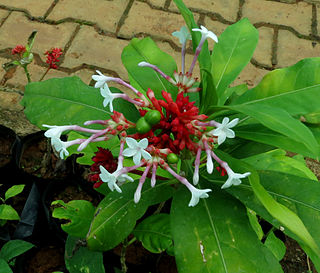
Apocynaceae is a family of flowering plants that includes trees, shrubs, herbs, stem succulents, and vines, commonly known as the dogbane family, because some taxa were used as dog poison. Members of the family are native to the European, Asian, African, Australian, and American tropics or subtropics, with some temperate members. The former family Asclepiadaceae is considered a subfamily of Apocynaceae and contains 348 genera. A list of Apocynaceae genera may be found here.

Rauvolfia is a genus of evergreen trees and shrubs, commonly known as devil peppers, in the family Apocynaceae. The genus is named to honor Leonhard Rauwolf. The genus can mainly be found in tropical regions of Africa, Asia, Latin America, and various oceanic islands.

Rauvolfia serpentina, the Indian snakeroot, devil pepper, or serpentine wood, is a species of flower in the milkweed family Apocynaceae. It is native to the Indian subcontinent and East Asia. Rauvolfia is a perennial undershrub widely distributed in India in the sub-Himalayan regions up to 1,000 metres (3,300 ft).

Voacangine is an alkaloid found predominantly in the root bark of the Voacanga africana tree, as well as in other plants such as Tabernanthe iboga, Tabernaemontana africana, Trachelospermum jasminoides, Tabernaemontana divaricata and Ervatamia yunnanensis. It is an iboga alkaloid which commonly serves as a precursor for the semi-synthesis of ibogaine. It has been demonstrated in animals to have similar anti-addictive properties to ibogaine itself. It also potentiates the effects of barbiturates. Under UV-A and UV-B light its crystals fluoresce blue-green, and it is soluble in ethanol.

Indole alkaloids are a class of alkaloids containing a structural moiety of indole; many indole alkaloids also include isoprene groups and are thus called terpene indole or secologanin tryptamine alkaloids. Containing more than 4100 known different compounds, it is one of the largest classes of alkaloids. Many of them possess significant physiological activity and some of them are used in medicine. The amino acid tryptophan is the biochemical precursor of indole alkaloids.

Ajmaline is an alkaloid that is classified as a 1-A antiarrhythmic agent. It is often used to induce arrhythmic contraction in patients suspected of having Brugada syndrome. Individuals suffering from Brugada syndrome will be more susceptible to the arrhythmogenic effects of the drug, and this can be observed on an electrocardiogram as an ST elevation.
In enzymology, a 1,2-dihydrovomilenine reductase (EC 1.3.1.73) is an enzyme that catalyzes the chemical reaction
Strictosidine synthase (EC 4.3.3.2) a key enzyme in alkaloid biosynthesis. It catalyses the condensation of tryptamine with secologanin to form strictosidine in a formal Pictet–Spengler reaction:

Corynanthine, also known as rauhimbine, is an alkaloid found in the Rauvolfia and Corynanthe genera of plants. It is one of the two diastereoisomers of yohimbine, the other being rauwolscine. It is also related to ajmalicine.

Rauvolfia tetraphylla is a plant in the family Apocynaceae, growing as a bush or small tree. It is commonly known as the be still tree or devil-pepper. The plant is native to Mexico, Central America, West Indies, and northern South America. It has been cultivated widely as both an ornamental and for use in traditional medicine. It is now naturalized throughout the tropics including Australasia, Indochina, and India.
Acetylajmaline esterase (EC 3.1.1.80, AAE, 2beta(R)-17-O-acetylajmalan:acetylesterase, acetylajmalan esterase) is an enzyme with systematic name 17-O-acetylajmaline O-acetylhydrolase. This enzyme catalyses the following chemical reaction

Akuammicine is a monoterpene indole alkaloid of the Vinca sub-group. It is found in the Apocynaceae family of plants including Picralima nitida, Vinca minor and the Aspidosperma.

Raucaffrinoline is an indole alkaloid isolated from the leaves of Rauvolfia yunnanensis.

Vinorine is an indole alkaloid isolated from Alstonia.

Affinisine is a monoterpenoid indole alkaloid which can be isolated from plants of the genus Tabernaemontana. Structurally it can be considered a member of the sarpagine alkaloid family and may be synthesized from tryptophan via a Pictet-Spengler reaction.

Rauvolfia nukuhivensis is a species of plant in the family Apocynaceae. It is endemic to Nuku Hiva in the Marquesas Islands in French Polynesia.

Serpentine is a terpene indole alkaloid produced by several members of the family Apocynaceae, including Catharanthus roseus and Rauvolfia serpentina.

Apparicine is a monoterpenoid indole alkaloid. It is named after Apparicio Duarte, a Brazilian botanist who studied the Aspidosperma species from which apparicine was first isolated. It was the first member of the vallesamine group of alkaloids to be isolated and have its structure established, which was first published in 1965. It has also been known by the synonyms gomezine, pericalline, and tabernoschizine.

Tabernaemontanine is a naturally occurring monoterpene indole alkaloid found in several species in the genus Tabernaemontana including Tabernaemontana divaricata.

Vobasine is a naturally occurring monoterpene indole alkaloid found in several species in the genus Tabernaemontana including Tabernaemontana divaricata.

















